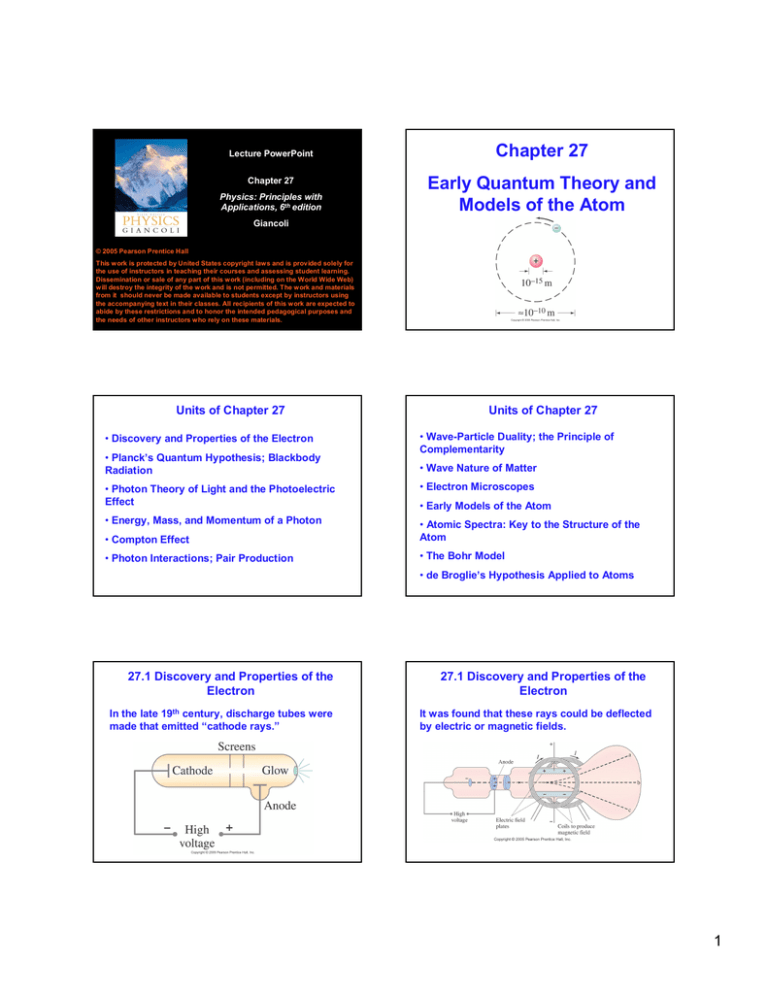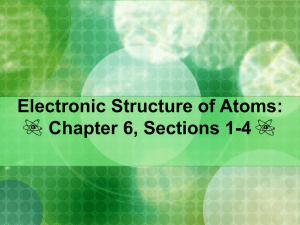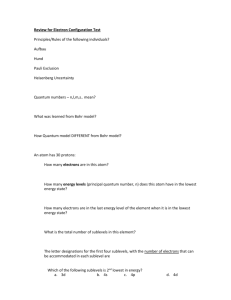
Lecture PowerPoint
Chapter 27
Physics: Principles with
Applications, 6th edition
Chapter 27
Early Quantum Theory and
Models of the Atom
Giancoli
© 2005 Pearson Prentice Hall
This work is protected by United States copyright laws and is provided solely for
the use of instructors in teaching their courses and assessing student learning.
Dissemination or sale of any part of this work (including on the World Wide Web)
will destroy the integrity of the work and is not permitted. The work and materials
from it should never be made available to students except by instructors using
the accompanying text in their classes. All recipients of this work are expected to
abide by these restrictions and to honor the intended pedagogical purposes and
the needs of other instructors who rely on these materials.
Units of Chapter 27
• Discovery and Properties of the Electron
• Planck’s Quantum Hypothesis; Blackbody
Radiation
• Photon Theory of Light and the Photoelectric
Effect
• Energy, Mass, and Momentum of a Photon
Units of Chapter 27
• Wave-Particle Duality; the Principle of
Complementarity
• Wave Nature of Matter
• Electron Microscopes
• Early Models of the Atom
• Compton Effect
• Atomic Spectra: Key to the Structure of the
Atom
• Photon Interactions; Pair Production
• The Bohr Model
• de Broglie’s Hypothesis Applied to Atoms
27.1 Discovery and Properties of the
Electron
In the late 19th century, discharge tubes were
made that emitted “cathode rays.”
27.1 Discovery and Properties of the
Electron
It was found that these rays could be deflected
by electric or magnetic fields.
1
27.1 Discovery and Properties of the
Electron
By accelerating the rays through a known
potential and then measuring the radius of their
path in a known magnetic field, the charge to
mass ratio could be measured:
(27-1)
27.1 Discovery and Properties of the
Electron
Cathode rays were soon called electrons.
Millikan devised an experiment to measure the
charge on the electron by measuring the
electric field needed to suspend an oil droplet
of known mass between parallel plates.
The result is
27.1 Discovery and Properties of the
Electron
The mass and charge of each droplet were
measured; careful analysis of the data showed
that the charge was always an integral multiple
of a smallest charge, e.
27.2 Planck’s Quantum Hypothesis;
Blackbody Radiation
All objects emit radiation whose total intensity is
proportional to the fourth power of their
temperature. This is called thermal radiation; a
blackbody is one that emits thermal radiation
only.
The spectrum of blackbody radiation has been
measured; it is found that the frequency of peak
intensity increases linearly with temperature.
λ pT = ( 2.9 ⋅10−3 ) m ⋅ K
27.1 Discovery and Properties of the
Electron
The currently accepted value of e is:
Knowing e allows the electron mass to be
calculated:
27.2 Planck’s Quantum Hypothesis;
Blackbody Radiation
This figure shows
blackbody radiation
curves for three
different temperatures.
Note that frequency
increases to the left.
(Wien's law)
2
27.2 Planck’s Quantum Hypothesis;
Blackbody Radiation
This spectrum could not be reproduced using
19th-century physics.
27.2 Planck’s Quantum Hypothesis;
Blackbody Radiation
Planck found the value of his constant by fitting
blackbody curves:
A solution was proposed by Max Planck in 1900:
The energy of atomic oscillations within atoms
cannot have an arbitrary value; it is related to the
frequency:
Planck’s proposal was that the energy of an
oscillation had to be an integral multiple of
hf. This is called the quantization of energy.
The constant h is now called Planck’s
constant.
27.3 Photon Theory of Light and the
Photoelectric Effect
Einstein suggested that, given the success of
Planck’s theory, light must be emitted in small
energy packets:
(27-4)
These tiny packets, or particles, are called
photons.
27.3 Photon Theory of Light and the
Photoelectric Effect
27.3 Photon Theory of Light and the
Photoelectric Effect
The photoelectric
effect: If light strikes a
metal, electrons are
emitted. The effect does
not occur if the
frequency of the light is
too low; the kinetic
energy of the electrons
increases with
frequency.
27.3 Photon Theory of Light and the
Photoelectric Effect
If light is particles, theory predicts:
If light is a wave, theory predicts:
1. Number of electrons and their energy should
increase with intensity
2. Frequency would not matter
• Increasing intensity increases number of
electrons but not energy
• Above a minimum energy required to break
atomic bond, kinetic energy will increase
linearly with frequency
• There is a cutoff frequency below which no
electrons will be emitted, regardless of
intensity
3
27.3 Photon Theory of Light and the
Photoelectric Effect
The particle theory assumes that an electron
absorbs a single photon.
Plotting the kinetic energy vs. frequency:
This shows clear
agreement with the
photon theory, and
not with wave
theory.
27.5 Compton Effect
Compton did experiments in which he
scattered X-rays from different materials. He
found that the scattered X-rays had a slightly
longer wavelength than the incident ones, and
that the wavelength depended on the
scattering angle.
27.4 Energy, Mass, and Momentum of a
Photon
Clearly, a photon must travel at the speed of
light. Looking at the relativistic equation for
momentum, it is clear that this can only
happen if its rest mass is zero.
We already know that the energy is hf; we can
put this in the relativistic energy-momentum
relation and find the momentum:
(27-6)
27.5 Compton Effect
This is another effect that is correctly predicted
by the photon model and not by the wave
model.
For a particle everything is determined by
energy and momentum conservation.
27.7 Wave-Particle Duality; the Principle of
Complementarity
The principle of complementarity states that
both the wave and particle aspects of light are
fundamental to its nature.
Indeed, waves and particles are just our
interpretations of how light behaves.
27.8 Wave Nature of Matter
Just as light sometimes behaves as a
particle, matter sometimes behaves like a
wave.
The wavelength of a particle of matter is:
(27-8)
This wavelength is extraordinarily small.
100-g ball with 10 m/s
λ = (6.6 ⋅10 −34 ) m
4
27.8 Wave Nature of Matter
The wave nature of matter becomes more
important for very light particles such as the
electron.
De Broglie wavelength
27.9 Electron Microscopes
Transmission electron
microscope – the electrons
are focused by magnetic
coils
Suppose an electron with kinetic energy 1 eV.
v= 2
EK
= 6 ⋅105 m/s
m
λ=
h
= 1.2 ⋅10 −9 m
mv
27.10 Early Models of the Atom
It was known that atoms were electrically neutral,
but that they could become charged, implying
that there were positive and negative charges
and that some of them could be removed.
27.10 Early Models of the Atom
Rutherford scattered alpha particles – helium
nuclei – from a metal foil and observed the
scattering angle. Some of the angles were far
larger than the plum-pudding model would
allow.
One popular atomic model
was the “plum-pudding”
model:
a bulk positive charge, with
negative electrons buried
throughout.
27.10 Early Models of the Atom
The only way to account for the large angles
was to assume that all the positive charge was
contained within a tiny volume – now we know
that the radius of the
nucleus is 1/10000
that of the atom.
27.11 Atomic Spectra
A very thin gas heated in a discharge tube
emits light only at characteristic frequencies.
This is called a line spectrum. If white light
passes through such a gas, it absorbs at those
same frequencies.
Therefore, Rutherford’s
model of the atom is
mostly empty space:
5
27.11 Atomic Spectra: Key to the Structure
of the Atom
The wavelengths of electrons emitted from
hydrogen have a regular pattern:
27.11 Atomic Spectra: Key to the Structure
of the Atom
Other series include the Lyman series:
(27-9)
And the Paschen series:
This is called the Balmer series. R is the
Rydberg constant:
27.11 Atomic Spectra: Key to the Structure
of the Atom
A portion of the complete spectrum of hydrogen
is shown here. The lines cannot be explained by
the Rutherford theory.
27.12 The Bohr Atom
Bohr found that the angular momentum
was quantized:
Relation to
De Broglie waves:
These are circular
standing waves for
n = 2, 3, and 5.
27.12 The Bohr Atom
Bohr proposed that the possible energy states
for atomic electrons were quantized – only
certain values were possible. Then the spectrum
could be explained as transitions from one level
to another.
27.13 de Broglie’s Hypothesis Applied to
Atoms
De Broglie’s hypothesis is the one associating
a wavelength with the momentum of a particle.
He proposed that only those orbits where the
wave would be a circular standing wave will
occur. This yields the same relation that Bohr
had proposed.
In addition, it makes more reasonable the fact
that the electrons do not radiate, as one would
otherwise expect from an accelerating charge.
6
27.12 The Bohr Atom
An electron is held in orbit by the Coulomb
force:
27.12 The Bohr Atom
Using the Coulomb force, we can calculate the
radii of the orbits:
(27-13)
(27-12)
27.12 The Bohr Atom
Summary of Chapter 27
• Planck’s hypothesis: molecular oscillation
energies are quantized
The lowest energy level
is called the ground
state; the others are
excited states.
Summary of Chapter 27
• Compton effect and pair production also
support photon theory
• Wave-particle duality – both light and matter
have both wave and particle properties
• Wavelength of an object:
• Light can be considered to consist of
photons, each of energy
• Photoelectric effect: incident photons
knock electrons out of material
Summary of Chapter 27
• Principle of complementarity: both wave and
particle properties are necessary for complete
understanding
• Rutherford showed that atom has tiny nucleus
• Line spectra are explained by electrons having
only certain specific orbits
• Ground state has the lowest energy; the others
are called excited states
7








